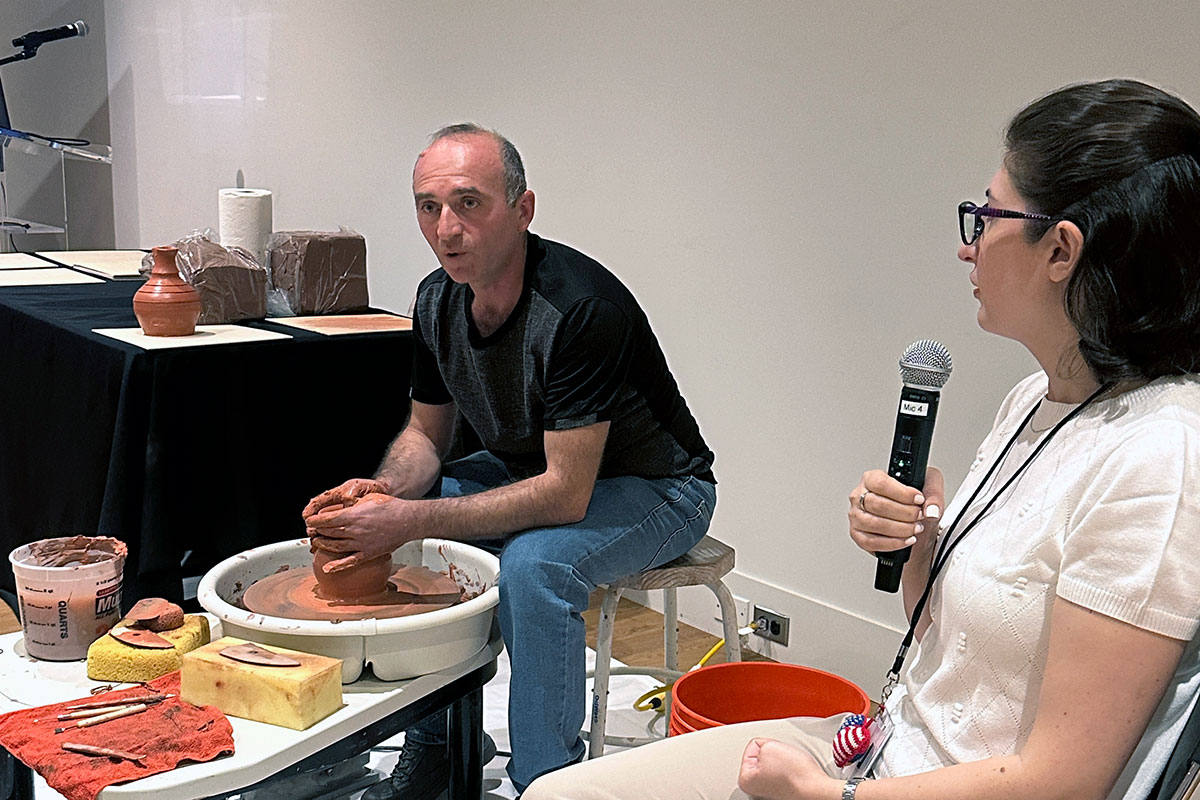In 2004, Vahagn Hambardzumyan founded Sisian Ceramics, a tribute to his Armenian hometown in Syunik Province, located four hours from the capital city of Yerevan. Together, Hambardzumyan and his wife, painter Zara Gasparyan, are dedicated to revitalizing Armenia’s cultural heritage through a harmonious blend of pottery, painting, and traditional cuisine.
In a post-Soviet era when ancient traditions have waned amid rapid industrialization and rural-to-urban migration, the couple contributes to the resurgence of these practices in Sisian, simultaneously fostering local ceramic expertise and promoting tourism. At the 2018 Smithsonian Folklife Festival, they both shared their craft traditions on the National Mall.
As part of the Center for Folklife and Cultural Heritage and National Museum of Asian Art’s Artisan in Residence Program, Hambardzumyan returned to Washington, D.C., in September 2023. Demonstrating his craftsmanship, he shared insights into his artistry, from sourcing clay in nearby mountains to using natural materials like beeswax, animal fat, and milk in his glazes. His week-long residency allowed museum visitors to delve into historical and symbolic aspects of his work, such as representations of the sun, mountains, and water.


On the last day of his residency, Hambardzumyan offered a hands-on workshop to twenty visitors to bring what they learned into reality by creating traditional Armenian-inspired pottery. With the support from cultural heritage presenter and translator Ashkhen Khudaverdyan, Hambardzumyan shared background on his craft and patiently showed each participant how to use a pottery wheel.
“It was such a delight getting the chance to work with Vahagn and Ashkhen during the residency,” said Janis Woodward, public programs coordinator at the museum. “It was a real privilege learning about Armenian culture and pottery, as well as witnessing Vahagn’s passion for his craft. I will need to take a trip to Sisian to see Vahagn’s studio and the amazing clay that he makes himself.”
Outside the public programs, Hambardzumyan explored D.C.’s pottery scene, visiting District Clay Center, Kuzeh Pottery, Hinckley Pottery, and Hollow Work. During each studio visit, he was given a private tour and the opportunity to work with clay at the wheel. District Clay also generously loaned their pottery wheel for the museum demonstration and workshop. Despite sourcing most supplies in Armenia, Hambardzumyan also enjoyed a visit to Clayworks Supplies near Alexandria, Virginia.


“I consider myself lucky to have yet another opportunity to showcase Armenian pottery culture and traditions in Washington, D.C., after the Folklife Festival in 2018,” Hambardzumyan said later. “While the Festival allowed me to share my pottery techniques with the public, during the residency I had the rare chance of not only demonstrating the techniques but presenting the historical and traditional meanings behind the making and finishing processes.
“I also was gifted with the rare chance of meeting peer potters and sharing experiences with them. During each meeting, I made a small clay gift to demonstrate and share my techniques with my colleagues. I was very excited to see, months later, Jahdiel Torres Cabá, who gave us a great tour at District Clay, finished the piece I started with his creative approach.”

The last studio Hambardzumyan visited was Hollow Work, a small-batch pottery studio in Northeast D.C., run by Kate Hardy, who is also a professor at the Corcoran School of Arts and Design at George Washington University. Hollow Work forms have clean lines and a handmade aesthetic. Hambardzumyan was drawn to Hardy’s work as they connected over processes and materials.
“Upon entering my studio, he got straight to asking questions—not only about my technique, equipment, and material but also about the concepts behind some of my pieces,” Hardy reported. “It truly felt as if we could’ve talked for hours and hours, sharing knowledge and our excitement about clay. I was also fortunate enough to have him sit at my wheel and throw a pot, which is now a part of my collection. Vahagn’s passion and pride in his craft are clear and inspiring. I’m very glad I’ve been able to expand my ceramics community to Armenia.”
No visit to D.C. was complete without savoring Armenian cuisine at Yerevan Cafe in Adams Morgan, sparking discussions about displaying Hambardzumyan’s ceramics in the restaurant. Back home in Sisian, Hambardzumyan and Gasparyan have expanded their enterprise to include studio workshops and a small restaurant, offering traditional Armenian food served on their own ceramic dishes. One of the traditional dishes they serve is qyalagyosh, a substantial soup that is usually eaten with friends and family and that can be made with dried buttermilk, spices, lentils, and onions. In every aspect, they are true custodians of heritage, bridging the past, present, and future of their crafts.

Beth Ferraro is the artisan coordinator working with the Center for Folklife and Cultural Heritage and the National Museum of Asian Art Museum on this pilot program. She is the curator at Gallery Y at the YMCA Anthony Bowen in D.C., teaches chair yoga to seniors, and serves as an art and community consultant under the name The Art Island.


